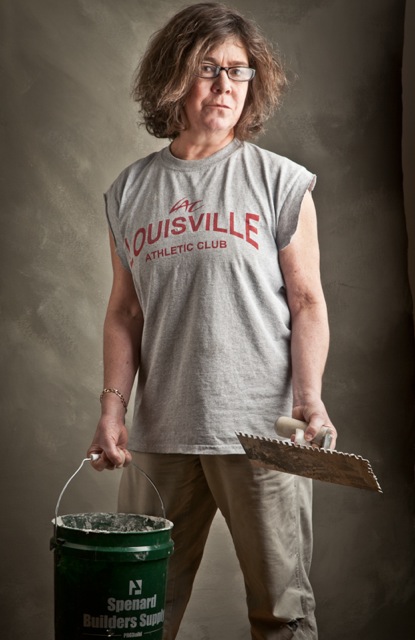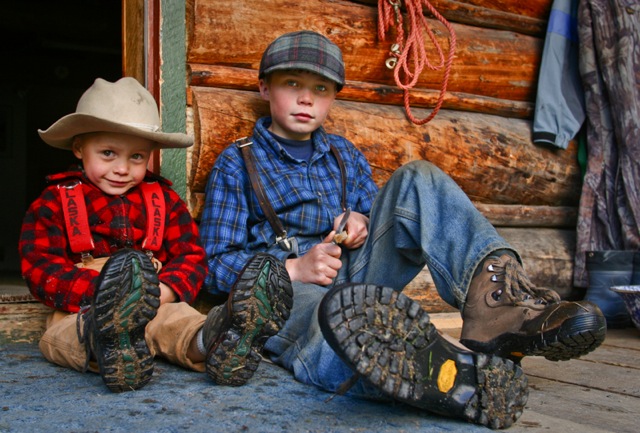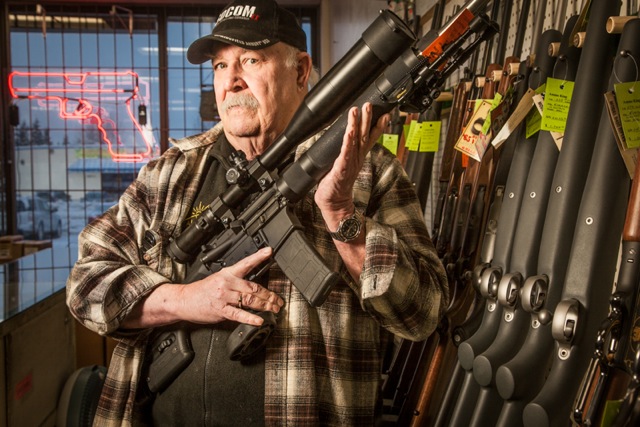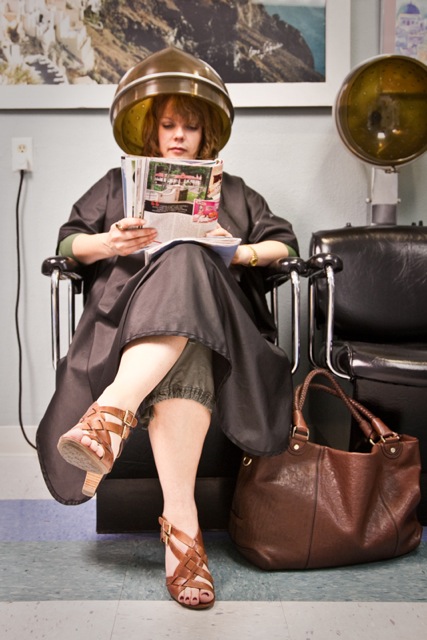On a May afternoon while our spring blizzard was slowly melting, I sat in the atrium of the Anchorage Museum eating my sandwich and looking. Looking up and around at Clark James Mishler’s portraits of Alaskans. Old, young, tattooed, the local famous and infamous, were all staring down at me and I returned their piercing glances. Hanging between pillars were banners imprinted with more Mishler folks: Native, Asian, and the stocking-capped athletic.
Surrounding the atrium and overhead in the balcony were huge foam-core photographic rectangles, resembling holiday cards– the kind sent by friends, that hang around until it’s time to take the tree to the recycler. Mishler’s unframed works hold large imagery juxtaposing a smaller image. At first glance, they feel informal; the more you look the more complex they become.
In the East and West balconies is glass shelving, resembling trophy cases. They contain a portion of Mishler’s Portrait a Day project, a photo diary he began January 2010 that, Mishler says, forces him to get out into the community. Like a musical score that changes speed for interest, his small photographic conquests provide visual contrast with the larger rectangles and heraldic hanging banners.
I sat drinking my orange Pellegrino, watching early summer tourists stop at enticing pictures. Were they surprised to find out we didn’t all look like Martians? Was it ‘color’ that drew them to Mishler’s works or some familiarity in the imagery?
In this exhibition there are portraits of locals I recognized. Mishler has captured the ubiquitous smile and expressive hands of Senator Arliss Sturgulewski in a way that Stieglitz captured Georgia O’Keeffe. There are the facial lines of Vic Fischer, abstracted just as the late mountaineer Bradford Washburn photographed striations of drifting snow. Mishler’s camera puts highlights into Fischer’s eyes so the viewer is stopped from venturing too far into the psyche of this biblical figure of Alaska’s Territorial days. Like a Ziegfeld chorus, former governors line up in black and white, complete with a cameo by Jay Hammond in his own space. Most agree if we could clone Hammond, even just his rugged exterior, we would.
What if I were a tourist and didn’t know who Van, owner of Marx Brothers, was? How would I react to his photo? In Chicago’s Millennium Park, snapshots are projected onto a tower-esque fountain; its waters have become a wading pool. Looking around at Second City faces, the real opposing the virtual, I’m a stranger who stares at what the videographer wanted me to see and believe in the narration.
At Mishler’s show I can’t erase my forty plus years of living in Anchorage, so I needed to force myself to dig into what this show is about. I thought about color and the occasional blurring out of photographic backgrounds, enough to make Mishler’s works artistic. His compositions are Formally successful. Not surprising, he’s a graduate of Art Center College of Design with an impressive resume: National Geographic, Rolling Stone, McDonalds, etc. So Mishler passes my aesthetic tests, I continued digging.
Everyone should bring her own story to an exhibition. I’ve spent most years in Alaska as a mom who went back to college and began a career when my children were in high school. Although I have non-white grandchildren, I’ve lived in an occidental world with the backdrop of Bush life as unfamiliar to me as if I’d just gotten off a cruise ship. Husband Dave’s law practice has allowed him to better interact with the state’s inhabitants and geography. Now that I work for him, I have been on fishing boats from Ketchikan to Homer but still mainly live within the Anchorage, Juneau, Fairbanks middle-class triangle.
What I began to see in this show was ‘sameness’ for what I’d seen elsewhere. The snuggling tattooed and pierced youth didn’t look much different than ones found in New York’s Central Park. Neither did the kids posing with their super-hero skateboards, or the guitar singing dude outside a 4th Avenue bar, backlit by storefront lighting reflected off snow.
Maybe it’s OK that we aren’t much different than browsers in a Lower 48 mall. I have a German friend, Gisela, who emails me about her house remodeling or her engaged daughter shopping at Ikea. I muse that living in Marburg isn’t a lot different than Anchorage where my trash needs to be put curbside and my daughters email me with their personal dramas.
‘We Alaskans’ are ornery and like same and different on our own terms. Yes, Mishler’s photos about shoveling snow or vegging-out on a neighbor’s stoop are comforting. Discovery is finding uniqueness when we feel ‘comfortable.’ According to a recent essay in the New York Times by the Nobel Prize winner Eric Kandel, “insight into another begins with understanding of oneself.” He continued, “art is incomplete without the perceptual and emotional involvement of the viewer.” I decided to find my Alaska in Mishler’s show. It didn’t matter if this exhibition had sameness, it reflected my life. Here are examples (either from the exhibition or Mishler’s book) that move into the aesthetic unique:

Mishler’s woman with a bucket and trowel is the epitome of an Alaska woman. She is wearing trendy eyewear and comfortable work clothes. Perhaps she came from Louisville, as announced by her logoed t-shirt. Maybe she found the worn top at a thrift store. It doesn’t matter if this woman is professional or a do-it-your-selfer, she exudes confidence. In the seventies and eighties I spent hours putting ‘band aids’ on our Hillside cabin in need of constant nailing and painting, all we could afford after Dave finished law school.

Mishler’s young boys pose in front of a cabin. They could be weekenders at a vacation retreat or year-round Bush inhabitants. Judging from their muddy boots, they play outdoors frequently. The little boy appears to be wearing oversized clothing that once belonged to the bigger child. What a pleasure to observe the older youth whittling instead of playing with electronic toys. The adult clothing at the right stands in for the missing parents. Adult supervision is felt, even though these two appear independent for their years, proud Alaskans as noted by the smaller child’s suspenders. In the late seventies, Dave and I dragged lumber in our International to Beaver Lake where we built a cabin. We learned carpentry by reading books from the Book Cache while our children complained of boredom, mosquitos and having to use a porta-potty. We sold the place when the first of our five began college as we needed them to get summer jobs in Anchorage.

An African-American is driving a vintage automobile, built at a time when life wasn’t so kind to those of color. Here, children ride in the back seat by choice. In spite of history, this gentleman remains loyal to America, flying the stars and stripes out his refurbished car, another symbol of postwar white America. He proudly wears an Obama baseball cap, slightly cocked. Most of the country thinks Alaskans all vote Republican; if you live here you know better. I like the contrasting textures. The automobile’s chrome opposes the clapboards and lattice-work at the top of the picture plane becoming a landscape. The man’s plaid shirt and his expression soften the composition.

I am probably the only person on my street who doesn’t own a gun. We live in a state and a country that loves guns but can’t figure out how to control them. Mishler’s gun piece is a magnificent set of ironies. Cold steel phallically lines up on the right side of the photo, contrasting with the artful neon gun, upper left. The gentleman who is hugging a hi-tech gun embodies softness: a very washed plaid shirt, his wrinkled skin and walrus mustache. His baseball cap pulls viewers into the center of the picture, keeping them from optically heading out upper left, into the nondescript parking lot on a cold morning. His kind grandfatherly expression presents puzzles when looking at all the killing machines he surrounds.

A woman under a beauty shop hair dryer could be anywhere USA. The slick, dated tile flooring contrasts with the rough textured abstract print above her head. Her accessories are in good condition but aren’t designer labeled. She is reading a typical waiting room gossip rag that shows a mansion contrasting with some cartoonish insert, giving Mishler’s photograph a Pop Art feel. Similarly, the painter, James Rosenquist used the bonnet hairdryer to heighten awareness of post-war technology. Textures abound as tubular steel chair arms contrast with fluid synthetics of the salon apron and the flesh of her bare limbs. The plugged in cord on the left keeps viewers focused while Mishler reminds us that life in Alaska keeps flowing daily as electrical current.
Come discover what effect Mishler’s virtual people have on the real folks who peruse the museum and find your Alaskan self. Portrait Alaska (through September 28) has informative wall tagging and you may be surprised to come upon a friend. The companion book Portrait Alaska is available at the Museum bookstore. Eric Kandel’s article is available here.



